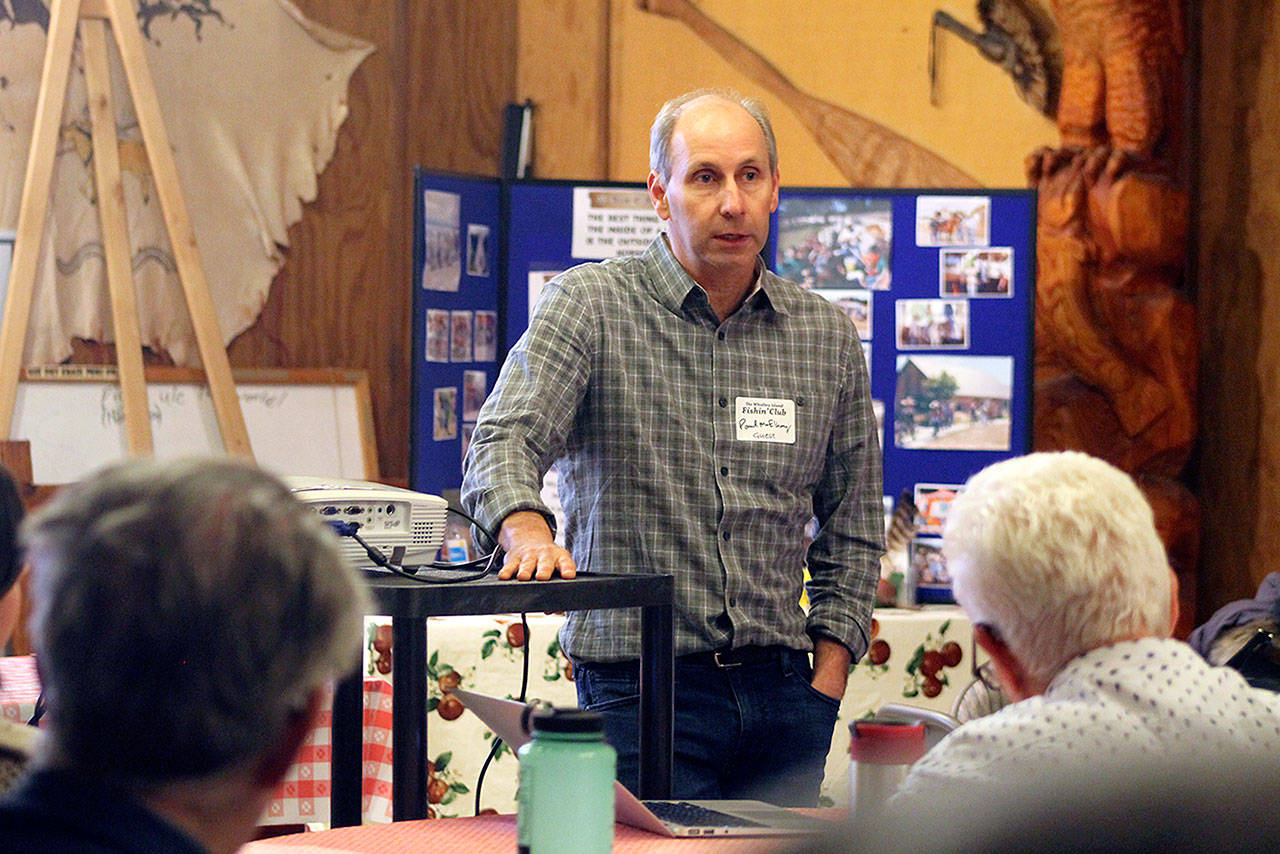Reversing the consequences of ocean acidification would be like steering the Titanic away from an iceberg.
Even if humanity stopped putting carbon dioxide (C02) into the atmosphere today, damage is still on the horizon.
That was the concluding message presented by Paul McElhany to about 30 members of The Fishin’ Club on Jan. 4 at the M-Bar-C Ranch in Freeland. McElhany, a research ecologist with the National Oceanic and Atmospheric Administration (NOAA), discussed what ocean acidification could mean for marine life in Puget Sound.
McElhany and Fisheries Biologist Danielle Perez, who both work at the Northwest Fisheries Science Center, explained that rising carbon dioxide levels from burning fossil fuels is being absorbed by the ocean. Ocean acidification is the process of greenhouse gases changing the chemistry of the water.
NOAA is studying how marine ecosystems will be affected by these changes. According to the International Institute for Applied Systems Analysis, many marine organisms rely on “equilibrated chemical conditions and pH levels in the ocean to build their calcium-based shells and other structures.” Decreasing pH levels, which indicates higher acidity, makes it more difficult for calcifying species, such as clams and mussels, to make their calcium structures.
McElhany’s team at the Northwest Fisheries Science Center’s Mukilteo Research Station conducts lab experiments on species found in waters surrounding Whidbey Island, particularly Dungeness crab and some salmon species. The multi-year experiments mimic current conditions of CO2 levels in a controlled environment as well as those expected decades into the future.
The team studies crabs and salmon from their larvae and juvenile stages to adulthood under long-term exposure. Most crab shells are made of chiten, but some have traces of carbon carbonate that would make them prone to erosion at lower pH levels.
It’s still unknown whether ocean acidification is negatively affecting adult crabs and salmon because research is ongoing. The work is difficult because it is long-term and multi-generational, he added.
“We’re not sure if it’s had any current effect on the crabs or salmon stocks in Puget Sound,” McElhany said. “But, what we’re trying to do is understand what we expect to see in the future.”
The team’s experiments have yielded some results though. They’ve found that crab larvae have lower survival and development rates when kept in environments concentrated in C02.
McElhany said there is more evidence to support that shellfish species like mussels and oysters are being negatively impacted because the calcium carbonate shells are more susceptible to acidification.
A shellfish company in Quilcene has been affected by CO2 in Daboo Bay, McElhany said, leading to a couple years with nearly total failures in production. While it’s difficult to pinpoint acidification as the only cause, McElhany said the company moved part of its operation to Hawaii to avoid future headaches in the area.
“It’s expected that it is going to become more and more of a problem,” McElhany said.
Ian Jefferds, general manager of Penn Cove Mussels, said his business is keeping an eye on the problem. He said it’s more of a concern along the coast during the summer upwelling season when deep waters, already low in pH and aragonite saturation, are brought to the surface where shellfish are spawning and shellfish larvae are endangered.
“Inland waters such as the Puget Sound appear to be a bit less susceptible presently to the effects of coastal upwelling,” wrote Jefferds, who is a member of the California Current Acidification Network.
The research station asked Kevin Lungren, president of The Fishin’ Club, to collect virgin female crabs for the studies. It ended up being easier said than done, as the female crabs were hard to find. Some specimens were eventually collected at nighttime.
Lungren felt McElhany’s example of the Titanic helped illustrate the need to study the effects of ocean acidification.
“We just can’t sit back and be complacent and wait for this,” Lungren said.
Lungren wondered if softer crab shells are a direct result of decreasing pH levels. McElhany said it’s unknown.
“Those kinds of studies haven’t been done on Dungeness crab,” McElhany said. “That’s one of the things we’re going to be looking at.”
The team is also determining what the multi-generational evolutionary responses will be, McElhany said.
Pam Kniseley, a Clinton resident and treasurer for the club, said the information was well presented and received favorably by attendees.
“I thought it was really interesting,” Kniseley said. “We have so many (members) that are crabbers.”
Barbara Bennett, who is presenting alongside McElhany at the annual Sound Waters University in February, also attended the meeting. Bennett, an environmental educator, said the findings indicate sea life are living shorter lives and gain less weight when they grow in acidic water.
Ultimately, the oceans are changing and sea life are responding to that in ways that are still being discovered, she said.
“The bottom line is that this is real,” Bennett said. “It will have an impact on our oceans, and that we all have an opportunity to be careful stewards of the ocean. That would directly relate to reducing our use of fossil fuels.”



